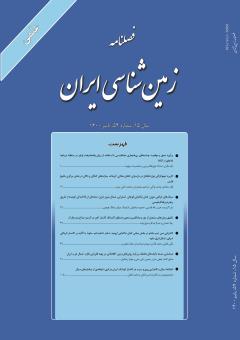کاربرد توموگرافی نوع تخلخل در بازسازی تکامل مخازن کربناته، سازندهای کنگان و دالان در بخش مرکزی خلیج فارس
محورهای موضوعی :فواد سجادی 1 , وحید توکلی 2 , ابراهیم سفیداری 3 , محمد امامی نیری 4
1 - دانشگاه تهران
2 - زمینشناسی
3 - پردیس علوم، دانشگاه تهران، ايران
4 - عضو هیئت علمی دانشگاه تهران
کلید واژه: بخش متراکم, کنگان و دالان, مدل انحراف سرعت, نگار انحراف سرعت ,
چکیده مقاله :
در این مطالعه، مدلسازی نگار انحراف سرعت بازسازی شده از نگارهای چاه پیمایی، برای تعیین انواع تخلخل موجود در سازندهای کربناته کنگان و دالان در یکی از میادین مرکزی خلیج فارس انجام شد. برای این منظور اطلاعات مغزه یک چاه شامل تخلخل، تراوایی و مطالعات پتروگرافی مقاطع نازک، به همراه نگارهای چاهپیمایی از 12 چاه دیگر مورد استفاده قرار گرفت. با استفاده از بازسازی نگار انحراف سرعت بر اساس نگارهای چگالی، نوترون و صوتی، سه زون انحراف سرعت با ویژگی تخلخل مشخص و یک زون بدون تخلخل شناسایی شد. مدل سهبعدی نگار انحراف سرعت پیشبینی شده در محل چاه ها نشان داد که زون K1 بیشتر متراکم و بدون تخلخل، در بعضی موارد دربرگیرنده تخلخل قالبی و تا حدود اندکی تخلخل بینبلوری است. این نوع تخلخلها در اثر کاهش سطح آب دریا در انتهای این واحد در نتیجه، انحلال و دولومیتیشدن تشکیل شده است. زون مخزنی K2 بیشتر دربرگیرنده تخلخل بینبلوری و به مقدار خیلی کمتر تخلخل قالبی است که نشاندهنده دولومیتیشدن در عمق کم آب در اغلب بخشهای این واحد است. بخش K3، بیشتر دربرگیرنده بخش متراکم و بدون تخلخل، تخلخل قالبی و به مقدار کمتر تخلخل شکستگی در بخش پایینی خود می باشد. زون مخزنی K4 در بخشهای بالایی دارای تخلخل از نوع بینبلوری و بینذرهای است که در عمق کم آب در انتهای تشکیل این واحد ایجاد شدهاند. تخلخلهای قالبی در اثر انحلال در بخش پایینی آن، در محیط دیاژنز جوی ایجاد شده است. در بعضی موارد تخلخل شکستگی در این واحد مشاهده میگردد. نتایج حاصل از مدلسازی نگار انحراف سرعت در این مطالعه، تطابق قابل قبولی با نتایج سایر مطالعات مخزنی دارد که نشاندهنده توانایی مدلسازی نگار انحراف سرعت در بررسی تغییرات بزرگمقیاس مخزنی است.
آقانباتی.، ع،1383. زمینشناسی ایران. انتشارات سازمان زمینشناسی و اکتشافات معدنی کشور، 707.
اسرافیلی دیزجی، ب.، 1387. بررسی ارتباط بین محیط رسوبی و کیفیت مخزنی بخش فوقانی سازند دالان و سازند کنگان در چاههای 9، 10 و 11 میدان گازی پارس جنوبی. رساله کارشناسی ارشد، دانشگاه تهران. 165.
درویش¬زاده، ع.، 1369. زمینشناسی ایران، چینه-شناسی، زمینساخت، دگرگونی و ماگماتیسم. انتشارات امیرکبیر، 434.
مطیعی ه.، 1374. زمینشناسی ایران زمینشناسی نفت زاگرس. سازمان زمینشناسی کشور، 537.
Ahr, W.M., 2011. Geology of carbonate reservoirs: the identification, description and characterization of hydrocarbon reservoirs in carbonate rocks. John Wiley and Sons.
Amel, H., Jafarian, A., Husinec, A., Koeshidayatullah, A. and Swennen, R., 2015. Microfacies, depositional environment and diagenetic evolution controls on the reservoir quality of the Permian Upper Dalan Formation, Kish Gas Field, Zagros Basin, Marine and petroleum geology, 67, 57-71.
Anselmetti, F.S. and Eberli, G.P., 1999. The velocity-deviation log: A tool to predict pore type and permeability trends in carbonate drill holes from sonic and porosity or density logs, American Association of Petroleum Geologists Bulletin, 83, 3, 450-466.
Berberian, M. and King, G.C.P., 1981. Towards a paleogeography and tectonic evolution of Iran. Canadian Journal of Earth Sciences, 18, 2, 210-265.
Esrafili-Dizaji, B. and Rahimpour-Bonab, H., 2009. Effects of depositional and diagenetic characteristics on carbonate reservoir quality: a case study from the South Pars gas field in the Persian Gulf” Petroleum Geoscience, 15, 325–344.
Eberli, G.P., Baechle, G.T., Anselmetti, F.S. and Incze, M.L., 2003. Factors controlling elastic properties in carbonate sediments and rocks, The Leading Edge, 22, 7, 654-660.
Geert, K., Afifi, A.M., Al-Hajri, S.I.A. and Droste, H.J., 2001. Paleozoic stratigraphy and hydrocarbon habitat of the Arabian Plate, GeoArabia, 6, 3, 407-442.
Lucia, F.J. and Major, R.P., 1994. Porosity evolution through hypersaline reflux dolomitization, in: Purser, B., Tucker, M., Zenger, D., (Eds.) Dolomites: International Association of Sedimentologists Special Publication, 21, 325–341.
Insalaco, E., Virgone, A., Courme, B., Gaillot, J., Kamali, M., Moallemi, A., Lotfpour, M. and Monibi, S., 2006. Upper Dalan Member and Kangan Formation between the Zagros Mountains and offshore Fars, Iran: depositional system, biostratigraphy and stratigraphic architecture. GeoArabia, 11, 2, 75-176.
Oliver, M.A., 2010. Geostatistical Applications for Precision Agriculture, Springer, 337.
Sfidari, E., Kadkhodaie-Ilkhchi, A., Rahimpour-Bbonab, H. and Soltani, B., 2014. A hybrid approach for litho-facies characterization in the framework of sequence stratigraphy: a case study from the South Pars gas field, the Persian Gulf basin. Journal of Petroleum Science and Engineering, 121, 87-102.
Sfidari, E., Amini, A., Kadkhodaie, A. and Ahmadi, B., 2012. Electrofacies clustering and a hybrid intelligent based method for porosity and permeability prediction in the South Pars Gas Field, Persian Gulf. Geopersia, 2, 2, 11-23.
Schlumberger, 2009, Petrel software help.
Sun, S. Q., 1995. Dolomite reservoirs: porosity evolution and reservoir characteristics, American Association of Petroleum Geologists Bulletin, 79, 186–204.
Tavakoli, V. and Jamalian, A., 2018. Microporosity evolution in Iranian reservoirs, Dalan and Dariyan formations, the central Persian Gulf Journal of Natural Gas Science and Engineering, 52, 155-165.
Tavakoli, V., Naderi-Khujin, M., and Seyedmehdi, Z., 2018. The end-Permian regression in the western Tethys: sedimentological and geochemical evidence from offshore the Persian Gulf, Iran Geo-Marine Letters, 38, 2, 179-192.
Warren, J., 2000. Dolomite, occurrence, evolution and economically important associations, Earth Science Reviews, 52, 1-181.


